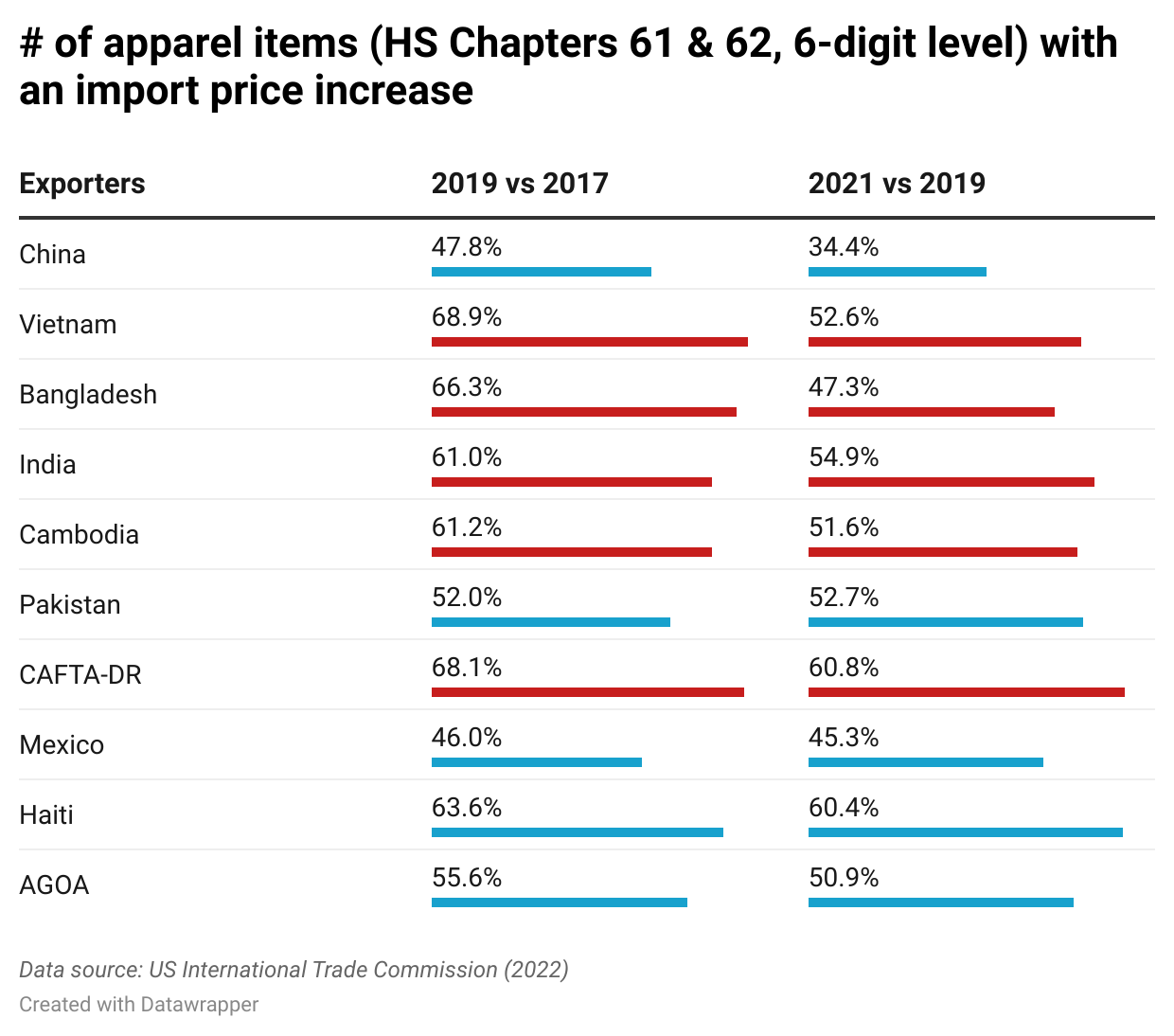In March 2018, the Trump administration imposed tariffs under Section 301 on Chinese imports. This significantly impacted apparel brands in the United States. While the tariffs were intended to address China's trade practices, they also increased costs for U.S. apparel companies by levying up to 25% tariffs on many Chinese-made goods, including textiles and clothing.1
With the tariffs in place, companies importing Chinese-made goods into the U.S. market face higher costs. As a result, brands had to decide whether to absorb the added costs, pass them on to consumers through higher prices or shift production to other countries. 
Some key impacts include:
- Increased production costs: Tariffs directly increased the cost of importing apparel from China, leading to slimmer margins for many brands. This affected pricing strategies and reduced profitability with some brands choosing to raise prices on their products, while others absorbed the cost.
- Supply chain shifts: To avoid the tariffs, many apparel brands began moving production out of China to countries like Vietnam, Bangladesh, and India, which had lower or no tariffs. Because these countries often lacked the scale and speed of China's manufacturing capabilities, the transition was not without challenges.
- Higher prices for consumers: Some brands passed on the higher costs to consumers, leading to more expensive apparel. This was particularly noticeable in segments like fast fashion, where small price increases can affect purchasing decisions.
- Impact on smaller brands: While larger brands with diversified supply chains were able to adapt more quickly, smaller and medium-sized apparel brands, which were heavily reliant on Chinese manufacturers, faced greater financial strain. The additional costs associated with shifting production or absorbing the tariffs could not easily be offset.
Section 301 under the current administration
The Biden administration has maintained the tariffs implemented during the Trump administration. In May 2024, it also announced additional tariff increases on $18 billion worth of Chinese goods, including semiconductors and electric vehicles, resulting in an added tax burden of $3.6 billion. This tax hike did not include textiles and apparel.2 (See chart.)
|
Product Group |
New Section 301 Tariff Rate |
Application Date |
Previous Section 301 Tariff Rate |
|
Battery parts (non-lithium-ion batteries) |
25% |
September 27, 2024 |
7.5% |
|
Electric vehicles |
100% |
September 27, 2024 |
25% |
|
Lithium-ion electrical vehicle batteries |
25% |
September 27, 2024 |
7.5% |
|
Surgical and non-surgical respirators and facemasks (first increase) |
25% |
September 27, 2024 |
7.5% |
|
Syringes and needles (excluding enteral syringes) |
100% |
September 27, 2024 |
0% |
|
Ship-to-shore gantry cranes |
25% |
September 27, 2024 |
0% |
|
Solar cells (whether or not assembled into modules) |
50% |
September 27, 2024 |
25% |
|
Steel and aluminum products |
25% |
September 27, 2024 |
0% or 7.5% |
|
Various critical minerals |
25% |
September 27, 2024 |
0% |
|
Semiconductors |
50% |
January 1, 2025 |
25% |
|
Rubber medical and surgical gloves (first increase) |
50% |
January 1, 2025 |
7.5% |
|
Disposable textile facemasks (first increase) |
25% |
January 1, 2025 |
7.5% |
|
Disposable textile facemasks (second increase) |
50% |
January 1, 2026 |
25% |
|
Surgical and non-surgical respirators and facemasks (second increase) |
50% |
January 1, 2026 |
25% |
|
Enteral syringes (exempted in 2024 and 2025) |
100% |
January 1, 2026 |
0% |
|
Lithium-ion non-electrical vehicle batteries |
25% |
January 1, 2026 |
7.5% |
|
Rubber medical and surgical gloves (second increase) |
100% |
January 1, 2026 |
50% |
|
Permanent magnets |
25% |
January 1, 2026 |
0% |
|
Natural graphite |
25% |
January 1, 2026 |
0% |
Table content from: https://www.whitecase.com/insight-alert/united-states-finalizes-section-301-tariff-increases-imports-china
Of note
It is also important to note that although apparel and textiles was not affected by the current rate hikes, in a September press release, the White House stated, “Section 301 tariffs currently cover approximately 40% of U.S. imports, including 70% of textile and apparel imports from China. Some e-commerce platforms and other foreign sellers circumvent these tariffs by shipping items from China to the United States claiming the de minimis exemption. If finalized, these goods would no longer be eligible for the de minimis exemption.”3
What does this mean for the future?
Apparel brands, especially those that manufacture globally, must remain aware of future changes or actions (such as the de minimis rule changes) and choose strategic partners that can help them navigate supply chain complexities and build strategies that bolster resilience to prevent major disruptions or excess costs. These retailers should explore building out a U.S. footprint rather than investing in or remaining across borders and implement strategies that minimize any impacts if they must pivot quickly.
Watch our on-demand webinar: Understanding the 321 de minimis rule changes
Watch a discussion between former White House Supply Coordinator Tim Manning and Cart.com President Ilias Simpson as they discuss the 321 de minimis rule changes, the intricacies of section 301 and how the rule changes may affect brands. Plus, hear the tips Tim and Ilias offered on navigating the rule changes and building a more resilient supply chain.
Find the recording here.
References:
- https://ustr.gov/sites/default/files/USTR%20Report%20Four%20Year%20Review%20of%20China%20Tech%20Transfer%20Section%20301.pdf
- https://shenglufashion.com/tag/section-301/
- https://www.whitehouse.gov/briefing-room/statements-releases/2024/09/13/fact-sheet-biden-harris-administration-announces-new-actions-to-protect-american-consumers-workers-and-businesses-by-cracking-down-on-de-minimis-shipments-with-unsafe-unfairly-traded-products/
Subscribe to our emails for the latest industry insights!
By entering your email, you agree to receive marketing emails from Cart.com






